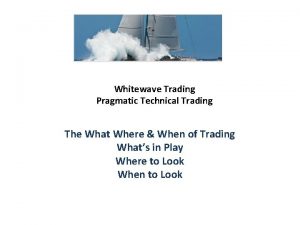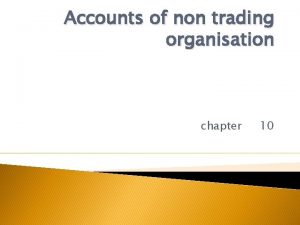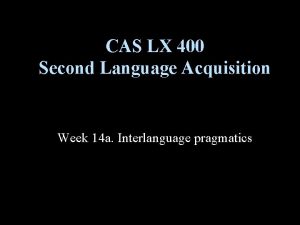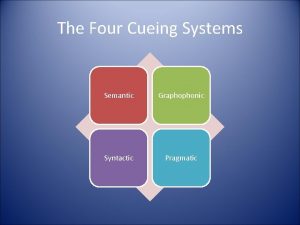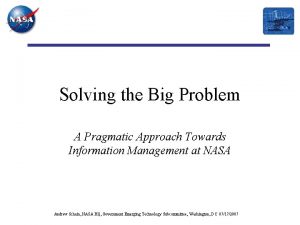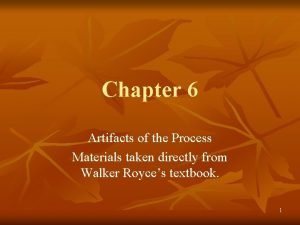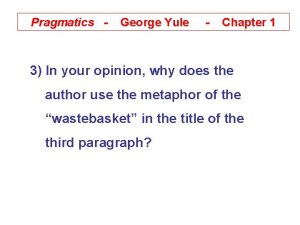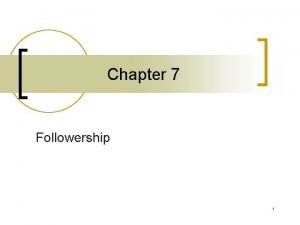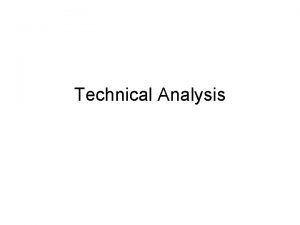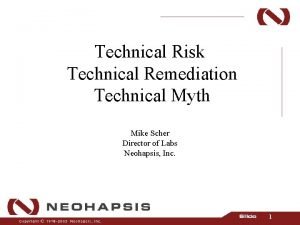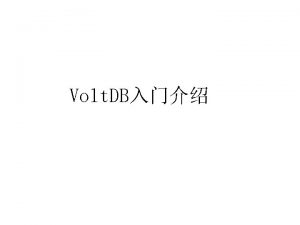Whitewave Trading Pragmatic Technical Trading The What Where











- Slides: 11

Whitewave Trading Pragmatic Technical Trading The What Where & When of Trading What’s in Play Where to Look When to Look

About Whitewave • Who follows us. • • Professional Full time Traders, Fund managers, active Day Traders, Private Wealth, Semi- Pros …Traders of every Ilk, deploying every imaginable trading strategy My clients trade pretty much everything, Equities, Equity Indices, Commodities, FX, and Bonds worldwide 23. 5 hours a day. What we do. . • Layout a blueprint of expected price action. How markets go from point A to B (where instruments start and stop) • Pick out daily key market drivers…(What Capital flows are in play) • Brevity!!!!! No one has time to read a book. • Idea generation…there is more than one way to do the same trade. • In a world where one instrument can effect many others, we try to find the one or two that are ( having the most effect) running the board. • We write something actionable everyday. • The levels written can be utilized by any Trader to either manage risk or for trade location on shorter time frame trading setups.

Trade Location • Attempting trades from the right side of the market at the correct technical level. • There are 2 compelling by-products to this mind set. • Less Risk!!!!! • Doing the right things “by maintaining good habits” will make you fundamentally correct. • The technicals turn before the story changes. • ETF traders…. Always defer to the underlying cash markets. • ETF’s can give false signals by overrunning or stopping short of the underlying tgt areas.

Level Trading • We only write significant areas that are go or no go levels. Expect price rejection at these levels or areas the first time in. Currencies or Oil… it’s typically an initial 60 - 80 points. Gold. . 8 -10 Dollars S&P 500 Futures… 5 -8 points 30 Yr. Bonds…app 1 full point or 32 ticks. Bunds. . 60 -80 points The general tolerance (wiggle) on these areas are as follows: 25 points in the Oil & Currencies…Yen 30 points. 2 dollars in the S&P 500 Futures and Gold ETF Traders…. levels are always best matched up with the underlying cash instruments. Levels are static until I change them. The highest % chance for a bounce is always the first time into the # set. The odds of a # working start going down with each successive area attempt.

Stops • The Stop is your friend. • By placing a stop in the correct spot you limit your downside. • It’s extremely helpful if you’re a fundamental trader since getting stopped out makes you reassess your original thesis for being in the trade. • You can always reevaluate and get back in. • There are only 3 reasons you get stopped out. . • 1 st your trade location and timing were incorrect. • 2 nd your original thesis was all wet • 3 rd you used a trailing stop for profit protection, which is a good thing

Time Frame Trading • We refer to the regional Bourse openings. This can be Europe’s opening and Asia’s close or the U. S. opening of Futures through London’s close and NYC ‘s lunch time. The bigger time frames always start and stop at the end or beginning of a major Financial centers trading hours. This is when we look for order flow to ebb, and possibly change direction. Futures are broken into 2 categories. All session or mini contracts and Chicago Pit session. You must have both up side by side next to the corresponding cash quotes or you are trading blind! I. E. Yen. . . JYM ( June Yen Pit session) 7: 20 A. M. - 2 P. M. CDT. JYAM ( the "A" standing for all session or 23 1/2 hours a day) is different. We track the opening ranges of the various time frames. You can't do that if you don't have them up. Opening Range. . the high low of the first 30 -60 seconds of trading in a particular time frame is the opening range. The opening of the Bond Futures and the Currencies occur In Chicago @ 7: 20 -7: 21 A. M. NYSE Stocks and Equity Indices. . . 8: 30 -31 A. M. CDT. This is the opening range I'm referring to. U. S. . . Equity Index Futures "Pit Session" Trade. . . 8: 30 A. M. CDT- 3: 15 P. M. CDT Symbols vary as to instrument depending on the quote provider. Please check with them as to their particular designations.

Outside Reversal Pattern 7/3/13. . FX. . . USD/JPY. . . 99. 50 (app 100. 50 Futures) is today's ORL #. 99. 20 is Yen resistance ( Dollar/Support) " app 100. 80 Futures”

Prudent use of RSI with OR Pattern 7/9/13…EURO. . . macro sell stops are under 127. 50…. 128. 09 is today's ORL #. Caution in looking for a lot of follow through to the down side, or taking the signal off the chart pattern, because the RSI's are too low for our Risk profile.

Trade Alerts • Our first inclination is to let a trader trade • Our professional Clientele value having our eyes on the overall board for market tells they may have overlooked. • We try to be patient for low Risk setups looking for 8 -10% trades for our less active Semi-Pro group and our pros with time constraints. • Trades rarely take more than 1 -2 days to develop. They either work or they don’t.

Quote Board #1 of 30

White. Wave Trading Strategies Independent Research from the Pros Pro We Trade to Make Money www. whitewavetradingstrategies. com info@whitewavetradingstrategies. com
